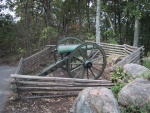Cannon
 From Conservapedia
From Conservapedia 

A cannon (Spanish: cañón, French: canon, German: Kanone, Greek: κανόνι, Italian: cannone, Japanese: 大砲 ) is a type of heavy weapon usually mounted on a carriage used since the Middle Ages.
Gunpowder, knowledge of which was most likely brought from China through the Arab world, was known in Europe by the first half of the thirteenth century. It took over 80 years for the substance to be used to propel a projectile. (First reported in a manuscript dated 1327.) Cannons got their first major workout at the Battle of Crecy in 1346.
The medieval cannon developed into a thing of many parts. Iron strips were placed round a wooden cylinder and welded together Two layers of iron hoops were then forced over the strips to hold them in place and seal any gaps. The wood was then burnt out. Whilst this method of manufacture allowed for larger weapons than the first rudimentary castings, they were still almost as dangerous to their operators as to the enemy, as they often blew up.
The first large single-cast cannon was made in 1543 in England. Its potential as a naval weapon was immediately identified and it is from this period that England began its climb to the top in naval warfare. It is also from about this time that the word “cannon” began to describe the weapon. That is when earlier terms such as “culverin” “falcon” "basilisk” were replaced by a word derived from the Greek “canna” – a hollow reed.
- (The word “gun” had always been used for the weapon – indeed the term was already being used to describe one of the weapons that the cannon replaced; the ballista. In that age-old habit of giving female names to weapons of war – "Big Bertha", "Brown Bess" etc – medieval soldiers in northern Europe were wont to refer to the ballista as “Gunne”, the pet name for “Gunnehildr" – an unfortunate name that has both its parts: “gunne” and “hildre” referring to “war”. It was natural that the lady would make the short step from one weapon to the other.)
Ammunition at this time and for centuries later ranged from solid iron balls, to chain shot and canister. They were muzzle loaded and thus slow to reload. Massed batteries were used on both land and sea. Their relatively short range limited them to direct fire only, as opposed to modern artillery which uses indirect fire.
The development of cannons led to the decline in importance of castles after the Medieval period, as troops in such immobile fortified positions could be very easily worn down by artillery fire. By the 17th century the "art" of fortification had become a science.

See also[edit]
- Firearm
- Gunpowder
- Castles
- Naval guns
Categories: [Weapons]
↧ Download as ZWI file | Last modified: 02/23/2023 15:24:37 | 96 views
☰ Source: https://www.conservapedia.com/Cannon | License: CC BY-SA 3.0
 ZWI signed:
ZWI signed: KSF
KSF